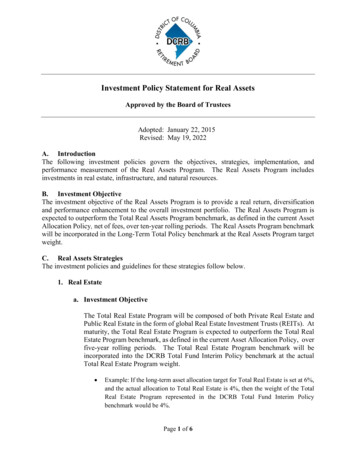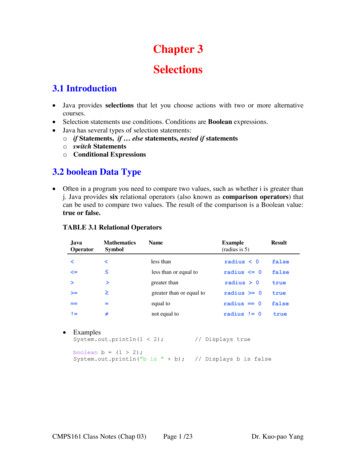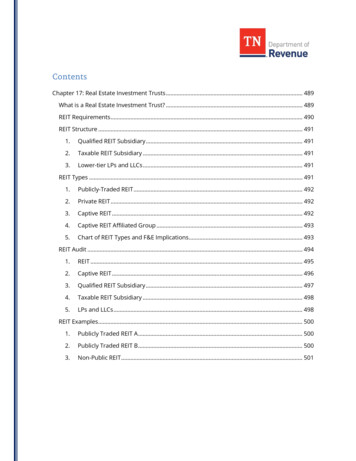
Transcription
Investment Policy Statement for Real AssetsApproved by the Board of TrusteesAdopted: January 22, 2015Revised: May 19, 2022A. IntroductionThe following investment policies govern the objectives, strategies, implementation, andperformance measurement of the Real Assets Program. The Real Assets Program includesinvestments in real estate, infrastructure, and natural resources.B. Investment ObjectiveThe investment objective of the Real Assets Program is to provide a real return, diversificationand performance enhancement to the overall investment portfolio. The Real Assets Program isexpected to outperform the Total Real Assets Program benchmark, as defined in the current AssetAllocation Policy, net of fees, over ten-year rolling periods. The Real Assets Program benchmarkwill be incorporated in the Long-Term Total Policy benchmark at the Real Assets Program targetweight.C. Real Assets StrategiesThe investment policies and guidelines for these strategies follow below.1. Real Estatea. Investment ObjectiveThe Total Real Estate Program will be composed of both Private Real Estate andPublic Real Estate in the form of global Real Estate Investment Trusts (REITs). Atmaturity, the Total Real Estate Program is expected to outperform the Total RealEstate Program benchmark, as defined in the current Asset Allocation Policy, overfive-year rolling periods. The Total Real Estate Program benchmark will beincorporated into the DCRB Total Fund Interim Policy benchmark at the actualTotal Real Estate Program weight. Example: If the long-term asset allocation target for Total Real Estate is set at 6%,and the actual allocation to Total Real Estate is 4%, then the weight of the TotalReal Estate Program represented in the DCRB Total Fund Interim Policybenchmark would be 4%.Page 1 of 6
The investment objective of the Private Real Estate Program is to enhance the totalfund performance through the investment in non-publicly traded vehicles thatinvest in a broad array of real estate properties and ventures by generating a longterm rate of return that exceeds that of publicly traded real estate securities. Privatereal estate investments are expected to be illiquid and long-term in nature. Atmaturity, the Private Real Estate Program is expected to outperform the PrivateReal Estate Program benchmark, as defined in the current Asset Allocation Policy,over five-year rolling periods.The investment objective of the Public Real Estate Program is to gain exposure tothe real estate asset class in a liquid and low-cost manner. As such, the Public RealEstate program will consist of passive investments in global REITs. Theperformance of the Public Real Estate Program is expected to equal the FTSEEPRA/NAREIT Global Index.b. Investment GuidelinesInvestment is authorized in vehicles that invest in a broad array of real estateproperties and ventures, including but not limited to: real estate partnerships,investments in private vehicles (e.g. limited partnerships or limited liabilitycompanies) that have an ownership interest, directly or indirectly, in real estateproperties through either the debt or equity, either income-producing or nonincome producing.The investment strategies may include those defined as Core, Core-plus, Value-addor Opportunistic. Core and Core-plus strategies derive their return primarily fromincome. Value-add strategies derive their return from both income and capitalappreciation. Opportunistic strategies derive their return primarily through capitalappreciation.2. Infrastructurea. Investment ObjectiveThe investment objective of the Infrastructure Program is to enhance the total fundperformance through the investment in non-publicly traded vehicles that invest ina broad array of infrastructure projects. Infrastructure investments are expected tobe illiquid and long-term in nature.Over the long-term, the Infrastructure Program is expected to outperform theInfrastructure Program benchmark, as defined in the current Asset AllocationPolicy, over five-year rolling periods. The Infrastructure benchmark will beincorporated into the Interim Total Policy benchmark at the actual InfrastructureProgram weight.b. Investment GuidelinesPage 2 of 6
Investment is authorized in vehicles that invest in a broad array of infrastructureinvestments, including but not limited to: investments in private vehicles (e.g.limited partnerships or limited liability companies) that have an ownership interestin physical structures, facilities and networks or ancillary services and equipmentwhich provide essential services to the public that are owned/operated eitherprivately or by government entities. Asset categories may include, but are notlimited to transportation, ports, utilities, energy (including “renewables”), water,communications, and social infrastructure sectors. “Renewables” refers to solar,wind, biomass, and hydro power generation, storage, and transmission. Socialinfrastructure refers to health care (hospitals), education (schools), judiciary(courthouse), emergency response (police and fire), and recreation (parks).The investment strategies may include those defined as “core” (Brownfield) or“growth” (Greenfield). “Core” (Brownfield) strategies refer to existing projectsthat are producing significant cash flow and derive much of their return throughincome. “Growth” strategies are projects that require new construction anddevelopment and derive their return from both income and appreciation.Infrastructure investments are stable and long-term in nature, and the cash flowsfrom the projects should have a positive correlation with inflation.3. Natural Resourcesa. Investment ObjectiveThe investment objective of the Natural Resources Program is to enhance the totalfund performance through the investment in non-publicly traded vehicles thatinvest in a variety of natural resource assets, including, but not limited to extractedenergy (oil & gas), metals and mining, timber, agriculture, and land. Suchinvestments are expected to be illiquid and long-term in nature.Over the long-term, the performance of the Natural Resources Program is expectedto exceed the Natural Resources Program benchmark, as defined in the currentAsset Allocation Policy, over five-year rolling periods. The Natural ResourcesProgram benchmark will be incorporated into the Interim Total Policy benchmarkat the actual Natural Resources Program weight.b. Investment GuidelinesInvestment is authorized in vehicles that invest in a broad array of assets, includingbut not limited to: investments in private vehicles (e.g. limited partnerships orlimited liability companies). Extracted energy investment strategies primarilyinclude but are not limited to those defined as “upstream”, “midstream”, or“downstream.” “Upstream” refers to the exploration and production (“E&P”) ofcrude oil, natural gas, coal, and other natural resource reserves. “Midstream” refersto the processing, transportation, and storage of oil and natural gas. “Downstream”Page 3 of 6
refers to the refining and distribution of oil and natural gas, as well as powergeneration. Metals and mining strategies include, but are not limited to, precious,base, and other mined minerals and metals. Timber strategies include, but are notlimited to, managed forests and tree farms. Agriculture and land strategies include,but are not limited to, the ownership of crop-producing farms and farmlandconversion and development.D.Investment Characteristics1. Investment Vehicles: The vehicles for private investments are typicallypartnerships but may include other entities such as limited liability companies oroffshore corporations. These investment vehicles may invest in a broad array ofprojects, ventures and natural resource assets.2. Property Type/Geographic Concentration: DCRB shall endeavor to limit thepotential for any one investment to negatively impact the long-term results of theReal Assets Program by investing across a variety of property types and geographiclocations.3. Investment Vehicle Concentration: DCRB shall not comprise more than 20%of total fund commitments (including amounts committed to its parallel vehicles)at final closing, and any one investment vehicle shall not comprise more than 10%of the Real Assets Program once it is fully invested, calculated on a committedcapital basis. The optimum number of investment vehicles in the portfolio and themaximum exposure to any one investment vehicle varies with time and will beevaluated as part of the annual plan for the Private Markets Investment Program.4. Investment Restriction: DCRB assets shall not be invested in real property locatedin the District of Columbia, Virginia or Maryland, or in loans, mortgages, bonds,or other certificates of indebtedness secured, in whole or in part, by real propertylocated in such jurisdictions. However, investment vehicles in the Real AssetsProgram may invest without regard to such specific jurisdictional limitationprovided such real assets investments in pooled vehicles do not constitute planassets under the DCRB and U.S. Department of Labor plan asset regulations.5. Investment Timing: DCRB shall strive to limit the potential for any oneinvestment to negatively impact the long-term results of the Real Assets Programby investing across business cycles and vintage years.6. Liquidity: Private real assets investments are illiquid and typically have expectedholding periods of at least 10-12 years (15-20 years in the case of privateinfrastructure). Investments are typically held until maturity and selling prior tomaturity may result in realizing a discount to fair market value. Liquidity risk ismanaged by minimizing the possibility of forced sales that may arise fromexceeding maximum exposure limits.Page 4 of 6
7. Distributed Securities: DCRB shall ordinarily direct the sale of securities whichare distributed by its investment vehicles, as soon as practically possible and striveto not impair the value of the security.8. Fund Performance Evaluation: Individual investment vehicle performance, asmeasured by the net internal rate of return and net investment multiple, will becompared to the respective vintage-year peer universe. It is recognized that manyimmature private market investments will ordinarily have a “J-curve effect,”whereby funds exhibit low to negative returns in the initial years due to thepayment of investment management fees when investments are typically stillcarried at cost and returns have not been realized yet.E.Selection Criteria, Monitoring, Performance Reporting and Trustee TrainingPlease refer to the Governance Policy for Alternative Investments for guidance.Page 5 of 6
DISTRICT OF COLUMBIA RETIREMENT BOARDRECORD OF OFFICIAL BOARD ACTIONSBoard Motion TallyDate: June 20, 2019To adopt the amended Investment Policy Statement for Real Assets as of June 20, 2019.Nay/No Vote/No Vote/MembersAyeAbsentOpposeAbstainRecuseAdams, JanXBlanchard, Lyle M.XBress, Joseph M.XClark, Joseph W.XCollins, Mary A.XDaniels, DeniseXHankins, Gary W.XHarris, TracyXPemberton, GreggoryXSmith, Edward C.XTippett, Thomas N.XWarren, Michael J.XPage 6 of 6
a. Investment Objective . The Total Real Estate Program will be composed of both Private Real Estate and Public Real Estate in the form of global Real Estate Investment Trusts (REITs). At maturity, the Total Real Estate Program is expected to outperform the Total Real Estate Program benchmark, as defined in the current Asset Allocation Policy, over










